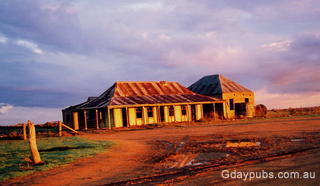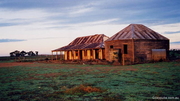
Former One Tree Hotel in Hay
Former One Tree Hotel
Former One Tree Hotel
Drive north out of Hay on the Cobb Highway and enter the New South Wales "Outback," land of the famed One Tree Hotel and Banjo Paterson's "Hay and Hell and Booligal." Some 38 kilometres from Hay you will see what is left of the famous and historic "One Tree Hotel." The hotel "Finch's Public House" or "Finch's Inn" was built in 1862 and was purchased by William Clark from Alexander Finch..
The hotel became known as the One Tree Hotel because of one large gum tree growing on a clay pan near a shallow fresh water well, about half a kilometre away from the hotel. What a famous landmark it was, as it stood against the far horizons. The bar of this hotel is still the same, as it was when it was in use some 50 years ago. The present owners, the McQuade family, have owned the hotel since the 1880's.
Article: "Pub Trivia from Picture Australia"
One Tree Hotel No.273.
Description:
A building which is an accurate 1903 replication of an 1862 hotel, the result of instructions by the Australian Mutual Fire Insurance Society after a fire, to replace the hotel with one identical to it. The building is of simple split pine log construction with verandahs on three sides and a hipped corrugated iron roof. Twelve paned windows are placed between the four panel doors which open along the verandahs. Detached kitchen and small weatherboard shed to rear. Internally the simple joinery and some fittings remain. Nothing remains of cattle yards and stables.
The first hotel known as Finch's Public House was built by Alexander Finch in 1862 near a large gum tree on the otherwise almost treeless plain stretching from Hay to Booligal. It soon became a landmark and the subject of many references in the poetry and prose writings of Henry Lawson and A B Paterson, One Tree often being referred to as Hell. The tree was destroyed in a storm on 1 January 1900.
History: Not Available
Condition and Integrity:
First building (1862) destroyed by fire and replaced with identical building (due to dispute over insurance) 1903. Stage post and watering place for Cobb and Co and passing mobs 1870-1900. Delicenced 1942.
Former One Tree Hotel
Photo: 01/10/2002
Photos submitted by: Jon G, Many Thanks
Former One Tree Hotel
Photo: 01/10/2002
The hotel was a thriving business until the licence was allowed to lapse in 1942. The family remained living there and lived off the sheep that they owned. After the death of their mother Frank McQuade and one of his sisters, Gladys, remained at the old hotel until Gladys retired to live in Melbourne. Frank lived in the remains of the hotel until he suffered a stroke in 1995 and passed away in July 1995 at the age of 82. Gladys still refuses to sell the property.
Former One Tree Hotel
Photo: c1922
The Cobb & Co. coaches must have been appreciated during the period 1860's to 1900 before there were many settlers in the One Tree area. They continued their valuable service until 1914. Mail as well as passengers was carried - leaving Hay for Booligal. Mossgiel, Ivanhoe and on to Wilcannia before returning to Hay. The coaches called briefly at the roadside hotels too, but at the One Tree Hotel, which was a staging change, the passengers partook of refreshments and tired horses were changed for a fresh team.
Former One Tree Hotel
Photo: Pre 1800's Photo submitted by Simpy. Information Jon Graham. Many Thanks.
The land on which the One Tree stands (640 acres) was originally part of the Ulonga Pastoral Holding No. 664. It was proclaimed a village on 20th March 1885, but it never became any larger. The hotel was of considerable size consisting of three sections, built with a high roof and wide verandahs. The buggy shed and spacious stables were to the north west of the hotel. To the west was an impressive stockyard capable of handling 5000 head of cattle. During the period, 1870 to 1900, there was constant movement of huge mobs of stock along the road. William Clark leased the big Government Tank that was nearby - watering up to 12,000 head of sheep at times. It was common place to water teams of 800 to 1000 horses and bullocks at one penny per head.




